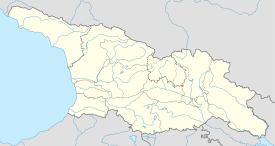
Tigva Monastery
| Tigva Monastery | |
|---|---|
 The Tigva church, c. 1890 | |
| Religion | |
| Affiliation | Georgian Orthodox Church |
| Location | |
| Location | Tigva, South Ossetia/Shida Kartli, Georgia |
| Geographic coordinates | 42°11′54″N 43°45′37″E / 42.198333°N 43.760278°E |
| Architecture | |
| Type | cross-in-square church |
| Completed | 1152 |
The Tigva Monastery of the Dormition of the Mother of God (Georgian: თიღვის მონასტერი) is a medieval Georgian Orthodox monastic church at the village of Tigva in the Prone river valley in what is now the disputed territory of South Ossetia. The monastery building is a domed cross-in-square design. It was founded by Tamar, daughter of King David IV of Georgia, who is commemorated in a Georgian inscription dated to 1152.

History
The foundation of the Tigva church is mentioned in the Georgian chronicles[1] and dated by the construction inscription to 1152. Its donor, or ktetor, was Tamar, daughter of the Georgian king David IV "the Builder" and the dowager-queen of Shirvan, who became a nun at Tigva and died there c. 1161.[2] By the early 18th-century, a crisis in Georgia had taken its toll on the monastery: Prince Vakhushti, in his Description of the Kingdom of Georgia, described the monastery at Tigva as "domed, elegant, beautifully built", but "without a priest". Several additional buildings surrounding the church, still extant in Vakhushti's times, were found in ruins by Countess Praskovya Uvarova during her visit in 1890.[3][4] Shortly after Uvarova's visit, the church was repaired through the efforts of the priest Zedginidze, princes Amirejibi, and local peasants in 1890.[5][6]

Architecture
The monastery building, built of blocks of hewn reddish stone, is a well-preserved cross-domed church, inscribed in a rectangle, with the dimensions of 15 x 24 m. Noted for ascetic design and paucity of decorations, the church has the altar with an apse and three rectangular transept arms. The prothesis and diaconicon are also apsed. The dome rests upon wall corners of the apse on the east and two free-standing pillars on the west. The characteristic feature is the presence of narthex and choir on the west. The church has three entrances, to the north, south, and west.[7][8] Mounted above the northern door is a Georgian inscription in the asomtavruli script, first published by Marie-Félicité Brosset in 1851.[9] Its rhymed text mentions Tamar, a donor. The interior was once frescoed, but the murals are now barely discernible.

To the north-west of the main church building was a two-storey palace, built for Tamar. It was directly connected to the church gallery by means of a bridge through a door cut in the western part of the north wall.[10]

References
- ^ Thomson, Robert W. (1996). Rewriting Caucasian history: the medieval Armenian adaptation of the Georgian chronicles; the original Georgian texts and the Armenian adaptation. Oxford: Clarendon Press. p. 325. ISBN 0198263732.
- ^ Hasan, Hadi (1929). Falaki-i-Shirwani: His Times, Life and Works. London: Royal Asiatic Society. p. 14.
- ^ Wakhoucht, Tsarévitch (1842). Brosset, Marie-Félicité (ed.). ღეოღრაჶიული აღწერა საქართველოჲსა. Description géographique de la Géorgie [Geographic description of Georgia] (in Georgian and French). S.-Pétersbourg: A la typographie de l'Academie Impériale des Sciences. pp. 264–265.
- ^ Uvarova, Praskovya (1894). Материалы по археологии Кавказа, собранные экспедициями Московского археологического общества. Вып. 4 [Materials for archaeology of the Caucasus, collected by the expeditions of the Moscow Archaeological Society, Issue 4] (in Russian). Moscow: Moscow Archaeological Society. pp. 165–172.
- ^ "თიღვის განთქმული ტაძარი ..." [The famous church of Tigva...] (PDF). Iveria (in Georgian). 185: 1–2. 29 August 1890.
- ^ "სოფ. თიღვა (გორის მაზრა)" [Village Tigva (Gori district)] (PDF). Iveria (in Georgian). 270: 2. 19 December 1890.
- ^ Gamkrelidze, Gela; Mindorashvili, Davit; Bragvadze, Zurab; Kvatsadze, Marine, eds. (2013). "თიღვა [Tigva]". ქართლის ცხოვრების ტოპოარქეოლოგიური ლექსიკონი [Topoarchaeological Dictionary of Kartlis Tskhovreba (The History of Georgia)] (PDF) (in Georgian) (1st ed.). Tbilisi: Georgian National Museum. p. 249. ISBN 978-9941-15-896-4.
- ^ Muskhelishvili, David; Tumanishvili, Dimitri; Gagoshidze, Iulon; Apakidze, Joni; Licheli, Vakhtang (2008). Skinner, Peter (ed.). The Cultural Heritage of Georgia — Abkhazeti, Shida Kartli (PDF). Tbilisi: Georgian Arts and Culture Center. p. 17.
- ^ Brosset, Marie-Félicité (1851). Rapports sur un voyage archéologique dans la Géorgie et dans l'Arménie [Report on archaeological voyages in Georgia and Armenia] (in French). St.-Petersbourg: Imprimerie de l'Académie Impériale des Sciences. pp. 105–107.
village de Thighwa.
- ^ Chitishvili, Natalia (2013). "King's and queen's place in the interior of the Georgian church" (PDF). Friends of Academic Research in Georgia. pp. 17–18. Retrieved 17 April 2017.
- Eastern Orthodox church buildings in Georgia (country)
- Georgian Orthodox monasteries
- 12th-century Eastern Orthodox church buildings
- Immovable Cultural Monuments of National Significance of Georgia
- Christian monasteries established in the 12th century
- 1152 establishments in Europe
- 1152 establishments in Asia
- 12th century in the Kingdom of Georgia
- Churches in South Ossetia
See what we do next...
OR
By submitting your email or phone number, you're giving mschf permission to send you email and/or recurring marketing texts. Data rates may apply. Text stop to cancel, help for help.
Success: You're subscribed now !

